| 
A
Weekend in Münster
In
early April, I received a phone call from my friend, Dunja
Baensch, in Germany, telling me about a dream she'd had. According
to her dream, I'd travelled to Germany in May for one of the
big race meets and we'd done all sorts of things together
- attended a show, participated in a seminar given by a veterinarian
physiotherapist, and gone to the Internationaler Sandbahnmeisterschaft
(International Sand Track Championship) in Münster.
I don't know about you but, when one of my friends calls and
says that she dreamt I'd gone to Europe, I take it as a sign.
Of course, I immediately booked myself a plane ticket! I was
particularly excited about this trip because I'd be able to
see Dunja's whippet, Yankee (Windyglen's Pilgrim), racing
and Yankee happens to have been sired by one of my whippets,
Tighe!
The first several days in Germany were spent doing a little
bit of sightseeing, visiting with friends, but mostly getting
ready for the 6 days we would be spending doing "dog
stuff". We left for Muenster early Wednesday afternoon
and, after arriving, spent the remainder of the day getting
the camp set up. We were to spend the weekend camping with
Birgit and Steffen Oberländer, breeders of my young German
import, Aragon aus dem Gnomenhain (Rogie).
On Thursday, the Muenster club was hosting a show. When she'd
learned I was coming to Germany, Birgit had emailed me, asking
me if I would like to handle Rogie's dam, Evelyn aus dem Gnomenreigen,
in the show. I readily agreed but warned Birgit that I wasn't
a very good handler. What I didn't tell her was that I had
never handled a dog in a real dog show before in my life!
In German shows, there is a class called the Gebrauchshundklasse
or "Working Dog Class". In order to be eligible
for this class, a dog must have been entered in a breed-related
performance event and twice finished in the top 50% of a minimum
number of starters. For whippets, dogs who have competed in
and achieved that level of success in either racing or lure
coursing events are eligible for entry in the Working Dog
Class.
Evelyn had been entered in the Working Class and, when the
catalogue was distributed, we saw she was the only entry.
Woo-hoo! A guaranteed win!
Although my only experience comes from the fun matches associated
with our racing nationals, the ring procedure was a little
different from what I've seen before. After entering the ring,
the dogs are immediately placed on the table for inspection
by the judge. (At this point, I explained to the judge that
I was visiting from abroad and would she mind if we spoke
English. She was very gracious and agreed to give me my ring
instructions in English.) On this day, there was an apprentice
judge also present and so they talked about Evelyn a little
bit during the table inspection, discussing particular points
of her structure.
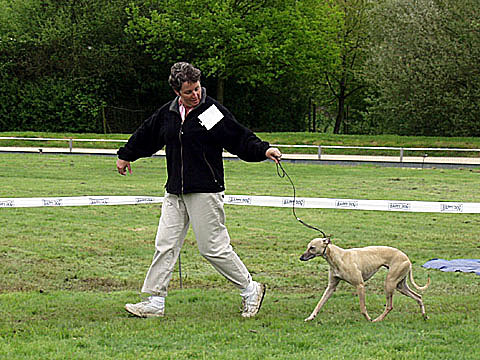
Evelyn aus dem Gnomenreigen and me
in the ring
Once that was completed, we were instructed to do the "go
around" and "down and back" things. I guess
that's the same everywhere. Once completed, we stood in front
of the judge's tent, while the judge dictated her critique
to the ring steward.
Every dog entered in a show is given a written critique by
the judge. The critique discusses the dog's merits and flaws;
the judge also assigns a rating to the dog. According to the
regulations governing FCI dog shows, five grades are available
to the judge:
VORZÜGLICH/EXCELLENT may only be awarded to a dog which
comes very close to the ideal standard of the breed, which
is presented in excellent condition, displays a harmonious,
well-balanced temperament, and is of high class and has excellent
posture. Its superior characteristics in respect of its breed
permit that minor imperfections can be ignored, it must however
have the typical features of its sex.
SEHR GUT/VERY GOOD may only awarded to a dog which possesses
the typical features of its breed and which has well-balanced
proportions and is in correct condition. A few minor faults
may be tolerated, but none of a morphological nature. This
award can only be granted to a dog which shows class.
GUT/GOOD is to be awarded to a dog which possesses the main
features of its breed however showing faults, subject to that
these are not concealed.
GENÜGEND/SUFFICIENT must be awarded to a dog which corresponds
adequately to its breed, without possessing the generally
accepted characteristics, or whose physical condition leaves
something to be desired.
DISQUALFIZIERT/DISQUALIFIED must be awarded to a dog which
does not correspond to the type required by the Standard,
which shows a behaviour clearly not in line with its standard
or aggressive behaviour, which has testicular abnormalities,
has dental flaw or a jaw anomaly, shows a colour and/or coat
imperfection or clearly shows signs of albinism. This qualification
shall also be awarded to dogs that correspond so little to
a single feature of the breed that its health is threatened.
It should furthermore awarded to dogs that show eliminating
faults in regard to the Breed Standard.
Dogs that cannot be awarded one of the above qualifications
shall be released from the ring with:
OHNE BEWERTUNG/CANNOT BE JUDGED : This rating to be given
to any dog, which does not move, constantly jumps up and down
on its handler or tries to get out of the ring which makes
it impossible to assess the gait and the movement or if a
dog avoids constantly to be examined by the judge and makes
it impossible to inspect bite and teeth, anatomy and structure,
tail or testicles, or if traces of operations or treatments
can be observed that seem to make attempted deception likely.
Same applies if the judge has ample reason to suspect operations
that were intended to correct the original condition or feature
(e.g. of the eyelid, ear or tail). The reason why the dog
got rated CANNOT BE JUDGED has to be stated in the written
report.
The four best dogs in each class are placed provided that
they have been awarded at least the qualification of "VERY
GOOD".
Since Evelyn was alone in her class, she naturally won it.
That meant we'd come back in the ring for the CAC award. Although
her placement was guaranteed, her rating was not…the
judge gave her a grade of V1 (Excellent) and also awarded
her a VDH award! The VDH is the national kennel club, the
German equivalent of the AKC. VDH awards are given at shows
to dogs of particular merit; when a dog has earned 5 VDH awards,
two in national shows and three in international shows, then
they are eligible for a VDH championship.
Back in the ring for the CAC award, there was no table inspection
but the rest of the time spent there was pretty much the same
as before. Down and back, around the ring...no instructions
in English this time though so I just followed along behind
everyone else. There were three whippet bitches in the ring:
Evelyn (from the Working Dog Class), Funny Girl of Gentle
Mind (the winner of the Open class), and Golden Peanut's Only
You (the winner of the Zwischenklasse, a class for
young whippets between the ages of 15 and 24 months).
First, the judge asked that Evelyn and Golden Peanut's Only
You go around the ring together. After we'd done that, the
judge spoke to the handler of the other dog and they left
the ring.
We were asked to take Evelyn and Funny Girl of Gentle Mind
around the ring together. Then down and back. Then around
again. The judge spoke to the handler of Funny Girl of Gentle
Mind, shook her hand, then turned to me, congratulated me
and said "Reserve CAC".
As a complete show novice, I had to ask my friend what it
meant. (And, in the remote chance that anyone else is as unknowing
as I was, it's the equivalent of Reserve Winner's Bitch.)
Needless to say, Birgit was thrilled. Reserve CAC from the
Working Dog class and her young bitch, Whipcat No Angel, from
Susanne Oschinski of Whipcat Whippets won Jugend/Puppy BOB
as well. It was quite a successful day for the Gnomenhain
kennel!
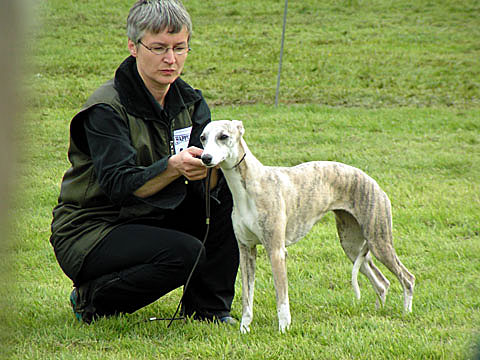
Birgit Oberländer with Whipcat
No Angel (Nelly)
On Friday, the scheduled training at the track was cancelled
due to rain. That left the day free for some non-doggy-related
sightseeing as well as some long walks with the dogs.
On Saturday, we attended seminar given by a veterinary physiotherapist,
Svenja Weiland of Tier Physiotherapie Zentrum Hannover, on
stretching and flexibility. The first two hours was devoted
to discussion of theory and the next several hours (around
three) were "hands-on". Surprisingly, I was able
to follow most of the theory section and understood about
60-70% of it. Fortunately for me, Dunja was able to translate
the rest.
The primary argument was that all canine athletes require
five things: power, speed, endurance, coordination, and flexibility.
Different sports require them in different proportions but
all are required by all sports. Then we drilled down into
"flexibility" and which parts of the anatomy are
involved in it: muscles, tendons, ligaments, and joint capsules.
Walking a dog out as warm up or giving it a massage focuses
only on the muscles and ignores the other three.
So, then we went into how and when to work
on improving flexibility. "How" was the specific
technique of doing passive range of motion exercises on one's
dog. "When" was suggested as a daily thing but also
as being especially suitable for both before and after exertion,
as it would reduce the incidence of injuries. These stretching
exercises can be employed not only to identify injured areas
but also as a way to heal them.
The remainder of the seminar was spent putting into practice
the techniques we'd seen demonstrated. Since I didn't have
any of my dogs with me, I "borrowed" one of Dunja's
dogs. Well, I borrowed half of her…Dunja performed the
stretching exercises on one side of her and then we flipped
her over and I did the other side!
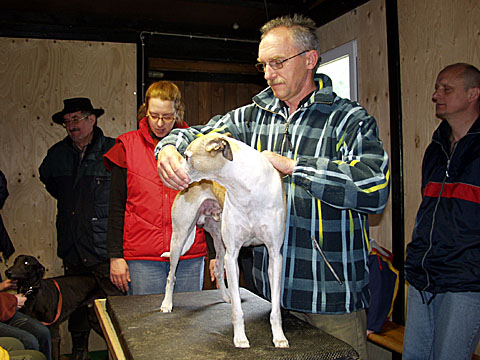
Owner Walter Krososka stretches his
dog, Glanmorgan Wasiri, under the guidance of veterinarian
Svenja Weiland
It was a very interesting and very informative seminar, with
the "hands-on" aspect being critical to understanding
the correct way to stretch out the dogs.
Sunday was race day. It was incredible...there were around
180 dogs racing, 78 of them were whippets. The track was like
nothing I've seen before; I thought the tracks I had seen
in Belgium and the Netherlands were great but they pale in
comparison to this one-the Muenster track is phenomenal. It's
a sand track with three starting boxes: one at 275m (for whippet
seniors, IGs, and some greyhounds), one at 480m (for all breeds
other than whippets and IGs), and one at 350m (for whippets).
Due to the track layout and the size of the entry, I was also
able to see more of the system of how they race in Europe
at this meet.
Before the race starts, the handlers and dogs are all waiting
outside the paddock. A person with a container of coloured
balls (it reminded me of a hand-held lotto machine) randomly
assigned the dogs to their boxes and then showed the owners
which box their dog would start in. Then, the box assignments
were indicated on the boxes themselves with a small placard.
The box operator and the paddock master are in the paddock
proper and there is a chain gate keeping out all others. The
paddock master gets a signal from the control booth when he
can let the handlers into the paddock via a traffic light
mounted on top of the control booth. This light swivels so
that it can be changed to point to the different boxes/paddocks.
Once the light is green, the paddock master lets all the handlers
into the paddock, where they line up at a designated spot
and remove their dogs' collars, etc.,. When they're ready,
the paddock master gives them the signal to load their dogs,
which they all do at the same time.
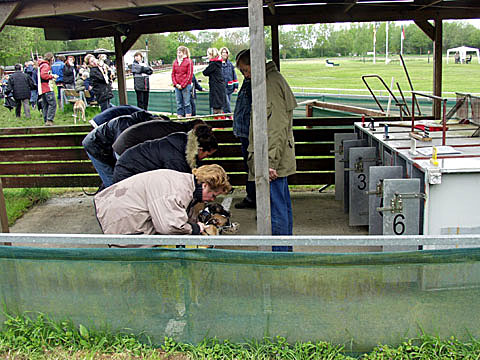
In the paddock, handlers wait for the
signal to load their dogs.
With the dogs in the boxes, the paddock master waves a flag
to signal the lure operator to start the lure. Münster
has a rail lure and it has a very distinctive harmonic hum
to it. The dogs all know the sound of that lure!
The box operator opens the boxes and away they go.
There were a couple of instances of interference in the races
and so I got to see how they were handled. There are three
judges in the infield of the racetrack who are responsible
for evaluating suspected interference. Additionally, there
are four officials positioned on each corner. Each one watches
only their assigned section of track. If there is a suspected
foul, then the three judges confer with the official of that
particular section of track and, after talking with him, they
then decide whether the incident was a foul or not. If yes,
then the dog is DQed.
The race meet itself is run on a completely different system
that the one used here in North America. Unlike our points
system, this race meet is based on times. There are three
"programs"; the initial program is set-up by the
race officials based on their knowledge of the entrants' speeds,
with the fastest dog wearing the #1 jacket. The make-up of
the second set of races is determined by the dogs' times in
their first run. Using each dog's fastest time as a determining
factor, only the six fastest dogs in each class advance to
the final.
A word about the classes - there are four classes for whippets,
each divided by sex: Seniors, Grundklasse (similar
to our Grade B racers), A-klasse (Grade A), and the
Sprinter class (a class for over-sized whippets).
As the FCI standard calls for a much smaller whippet than
the North American standards, Yankee (who, at barely 21.5"
tall, is "over-size" for Europe!) runs in the Sprinter
class. Two of his frequent competitors are Iron Heart of Good
Family and Indiana Jones of Good Family, two brothers who
are "nephews" of my bitch, Streaka. I was very excited
to see their races, as I knew one of my "relatives"
was bound to win the blanket!
Yankee's races were great. In his first race, he ran with
Iron Heart of Good Family, Ghan buri ghan's Buccaneer Binjai,
and Ypocrate de l'Enigme du Sphinx. Iron Heart won with a
time of 23.52s and Yankee was second with a time of 23.62s.
In the other sprinter race, Indiana Jones of Good Family won
handily with a time of 23.97s.
In the second program, Iron Heart and Indiana Jones ran together
with two other dogs for a very close finish. Ultimately, Indiana
Jones won with a time of 23.74s over his brother, who had
a time of 23.77s. Yankee won his second program race with
a time of 23.61s.
Before the final program, a squall passed over through the
area, making the track even wetter than it had been previously.
With each successive race, the track became deeper and muckier.
Despite that, it looked like the final would be an exciting
one, with those three boys all very strong and all very evenly
matched!
As I mentioned before, only the six fastest dogs make it to
the final and the jackets are determined by each dog's fastest
time. In this case, the six finalists were Iron Heart of Good
Family (#1), Windyglen's Pilgrim (#2), Indiana Jones of Good
Family (#3), Ypocrate de l'Enigme du Sphinx (#4), Yellow Feet's
Anton (#5), and Smoky vom Meatloaf (#6).
We'd hoped for an inside box for Yankee but to no avail. Smoky
drew the number one box, Iron Heart was in the number two
box, then Ypocrate, Yankee, Indiana Jones, and Anton. Smoky,
Iron Heart, Ypocrate, and Indiana Jones broke together ahead
of Yankee and then finally Anton. Despite a slightly slower
start, Yankee held firm to his box position and did not give
any ground to the two dogs on his outside.
Going into the corner, Smoky, Iron Heart, and Ypocrate were
three-deep and moving like a single dog. As they came out
of the corner, first Ypocrate and then Iron Heart nosed into
the first position. Yankee, on their outside, accelerated
quickly coming out of the corner and overtook them for the
lead. As they ran down the backstretch, Yankee lengthened
his lead and Indiana Jones worked his way through the pack
to gain second place. In the final corner, the race was on
for third, with Iron Heart on the rail, working hard to get
past Ypocrate.
Through turns three and four, Yankee was in the lead by two
lengths but Indiana Jones, in second, was a strong competitor.
Sometimes the lead dog will become complacent in their lead,
leaving them open to be overtaken at the line. Could Yankee
hold his lead?
As they came out of the final corner, Yankee went wide, leaving
room for Indiana Jones to pass on his inside. In fact, he
ran so wide that he was running on pristine track; no dogs
had run that wide all day! It seemed a huge tactical error
on Yankee's part but Indiana Jones was unable to take advantage
of the opening. As Yankee ran on the firmer, fresh sand, Indiana
Jones was forced to stay on the rail where the sand was deep
and mucky.
Yankee held his lead and crossed the finish line almost two-tenths
of a second ahead of Indy. He'd won the Sandbahnmeisterschaft!
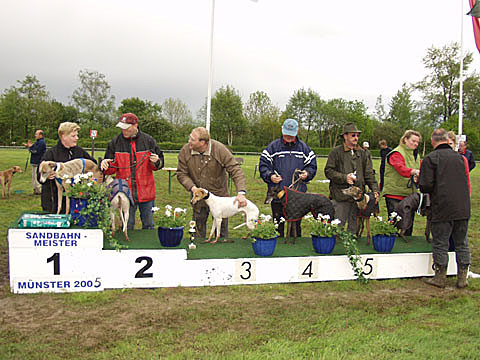
On the podium, (l-r) Windyglen’s
Pilgrim, Indiana Jones of Good Family, Iron Heart of Good
Family, Ypocrate de l’Enigme du Sphinx, Yellow Feet’s
Anton, Smoky vom Meatloaf
Upon the completion of all the races, the competitors of each
final proceeded to the podiums, where they were presented
with their awards and, in the case of the first place finishers,
their blankets. In addition to the racing awards, the club
offered special Schönheit und Leistung awards.
Literally translated, Schönheit und Leistung
means "Beauty and Performance". These trophies were
awarded to the dog in each class who had attained the highest
combined level from both the show on Thursday and the races
on Sunday.
Evelyn, the bitch I'd handled in the show (and Rogie's mother),
had won the A-class whippet bitch Schönheit und Leistung
award!
While Birgit ran to get Evelyn, I headed to the infield with
my camera to get ready to take her picture on the podium.
Instead, after she brought Evelyn to the podium area, Birgit
asked me if I would like to take her to the podium to accept
the award. Needless to say, I was thrilled and more than a
little bit proud of my new whippet buddy.
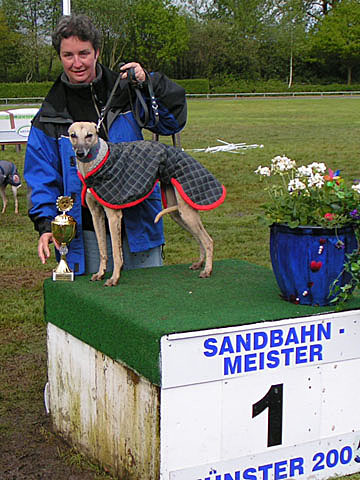
Evelyn on the podium, accepting her
Schönheit und Leistung award
After an exciting day, we all spent the evening relaxing and
pampering the dogs. While some people had packed up and headed
for home, we'd elected to stay one more night at the track.
The following morning, we joined members of the WRV Münster
club for their traditional Frühstück (breakfast)
in the clubhouse. It gave Dunja and me a chance to visit with
new friends in a relaxed setting. After breakfast, Karl-Heinz
Mittelfarwick, the club's racing coordinator, gave me a tour
of the track's control booth. I can only dream that one day
we might have a track like the one in Münster here in
North America.
(Click
here to see a panoramic photo of the Münster track!)
All too soon, it was time say our good-byes and return to
Cologne. The next day, I'd be on my way home. The weekend
had been a huge success, not only for the dogs but also for
me. I'd been able to participate in my first dog show, attend
an informative and useful veterinary seminar, and watch one
of the biggest race meets in Europe. More importantly, I'd
spent a weekend with friends, both new and old, and the dogs
we love.
|
![]()